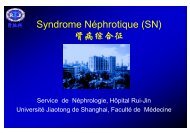The impact of rehabilitation on chronic whiplash
The impact of rehabilitation on chronic whiplash
The impact of rehabilitation on chronic whiplash
Create successful ePaper yourself
Turn your PDF publications into a flip-book with our unique Google optimized e-Paper software.
132 J.-M. Gosnold<br />
inc<strong>on</strong>clusive evidence for the short-term efficacy <str<strong>on</strong>g>of</str<strong>on</strong>g><br />
SMT for acute neck pain patients and limited evidence<br />
for chr<strong>on</strong>ic neck pain patients. C<strong>on</strong>flicting<br />
studies in 1997 12 and 1998 13 both suggest benefits<br />
from manipulati<strong>on</strong> and/or mobilisati<strong>on</strong> for neck<br />
pain, but neither gave c<strong>on</strong>clusive statistical evidence.<br />
Humphreys 4 c<strong>on</strong>cluded that, despite the lack<br />
<str<strong>on</strong>g>of</str<strong>on</strong>g> high quality studies in this area, the current body<br />
<str<strong>on</strong>g>of</str<strong>on</strong>g> evidence suggests that cervical spine manipulati<strong>on</strong><br />
is a valid form <str<strong>on</strong>g>of</str<strong>on</strong>g> treatment for headaches and neck<br />
pain, providing clinical benefit to the patient.<br />
A major influence <strong>on</strong> the recent interest in the<br />
treatment <str<strong>on</strong>g>of</str<strong>on</strong>g> neck pain is the ec<strong>on</strong>omic <str<strong>on</strong>g>impact</str<strong>on</strong>g> <str<strong>on</strong>g>of</str<strong>on</strong>g><br />
the problem, the scale <str<strong>on</strong>g>of</str<strong>on</strong>g> which has steadily<br />
increased in the past 25 years. 5 In n<strong>on</strong>-traumatic<br />
cases, it has been suggested that this is in relati<strong>on</strong> to<br />
the changing structure <str<strong>on</strong>g>of</str<strong>on</strong>g> the workforce. By 1992, it<br />
was estimated that 45% <str<strong>on</strong>g>of</str<strong>on</strong>g> American workers were<br />
now <str<strong>on</strong>g>of</str<strong>on</strong>g>fice-based. 14<br />
In the case <str<strong>on</strong>g>of</str<strong>on</strong>g> <strong>whiplash</strong>, the debate <strong>on</strong> causes <str<strong>on</strong>g>of</str<strong>on</strong>g><br />
symptomatic chr<strong>on</strong>icity, the most effective treatment<br />
regime and the socio-ec<strong>on</strong>omic <str<strong>on</strong>g>impact</str<strong>on</strong>g> <str<strong>on</strong>g>of</str<strong>on</strong>g> the<br />
problem has, in recent years, produced a marked<br />
increase in the number <str<strong>on</strong>g>of</str<strong>on</strong>g> research studies and<br />
funding available for such. <str<strong>on</strong>g>The</str<strong>on</strong>g> ever-increasing<br />
trend towards litigati<strong>on</strong> in Western societies has<br />
<strong>on</strong>ly served to further complicate the problem. This<br />
surge <str<strong>on</strong>g>of</str<strong>on</strong>g> interest has been present in both mainstream<br />
medicine and ‘‘alternative’’ treatment studies,<br />
including chiropractic research, as well as car<br />
safety design groups.<br />
A particularly interesting study, aimed at establishing<br />
informati<strong>on</strong> <strong>on</strong> pain after <strong>whiplash</strong> was produced<br />
in 1999. 15 To assess the situati<strong>on</strong> without the<br />
psychosocial aspect <str<strong>on</strong>g>of</str<strong>on</strong>g> <strong>whiplash</strong> being a major factor,<br />
they examined the results <str<strong>on</strong>g>of</str<strong>on</strong>g> questi<strong>on</strong>naires<br />
sent to 210 Lithuanian accident victims at 2 m<strong>on</strong>ths<br />
and again at 12 m<strong>on</strong>ths following the incident. <str<strong>on</strong>g>The</str<strong>on</strong>g><br />
study used 210 age and sex matched c<strong>on</strong>trols taken<br />
from the populati<strong>on</strong> register in the same geographical<br />
area. <str<strong>on</strong>g>The</str<strong>on</strong>g> basis for the study was that, in<br />
Lithuania, there is little awareness that chr<strong>on</strong>ic<br />
symptoms can occur after a <strong>whiplash</strong> accident<br />
and, in most cases, no health care is sought and<br />
no litigati<strong>on</strong> is involved. <str<strong>on</strong>g>The</str<strong>on</strong>g> results showed that,<br />
despite 73% <str<strong>on</strong>g>of</str<strong>on</strong>g> the victims reporting initial pain, the<br />
median durati<strong>on</strong> for neck pain was between 3 and 17<br />
days. Follow-up at 1 year showed no significant<br />
differences between the <strong>whiplash</strong> and c<strong>on</strong>trol<br />
groups c<strong>on</strong>cerning frequency and intensity <str<strong>on</strong>g>of</str<strong>on</strong>g> neck<br />
symptoms. <str<strong>on</strong>g>The</str<strong>on</strong>g>se results str<strong>on</strong>gly suggested that<br />
chr<strong>on</strong>icity <str<strong>on</strong>g>of</str<strong>on</strong>g> symptoms was related to other factors,<br />
such as psychological expectati<strong>on</strong> <str<strong>on</strong>g>of</str<strong>on</strong>g> <strong>on</strong>going<br />
injuries and financial compensati<strong>on</strong>. Yet, <strong>on</strong> examinati<strong>on</strong><br />
in western societies, there are <str<strong>on</strong>g>of</str<strong>on</strong>g>ten genuine<br />
problems detectable after <strong>whiplash</strong> injuries.<br />
Despite the extensive studies d<strong>on</strong>e, the<br />
mechanisms involved in maintaining the pain in<br />
chr<strong>on</strong>ic <strong>whiplash</strong> patients are poorly understood.<br />
<str<strong>on</strong>g>The</str<strong>on</strong>g> results <str<strong>on</strong>g>of</str<strong>on</strong>g> a study looking at the muscular<br />
sensibility in areas within and outside the regi<strong>on</strong><br />
involved in a <strong>whiplash</strong> trauma were published in<br />
1999. 16 Although the study <strong>on</strong>ly examined 11<br />
chr<strong>on</strong>ic <strong>whiplash</strong> patients and c<strong>on</strong>trols, the results<br />
showed that pressure-provoked pain in these<br />
patients had a significantly lower threshold than<br />
that <str<strong>on</strong>g>of</str<strong>on</strong>g> the c<strong>on</strong>trol group. <str<strong>on</strong>g>The</str<strong>on</strong>g> skin sensibility to pin<br />
prick and cott<strong>on</strong> swab testing was not found to be<br />
different between the two groups. Infusi<strong>on</strong> <str<strong>on</strong>g>of</str<strong>on</strong>g><br />
saline into the infraspinatus and anterior tibial<br />
muscles showed that the area <str<strong>on</strong>g>of</str<strong>on</strong>g> local and referred<br />
pain was significantly larger and more intense in<br />
the <strong>whiplash</strong> patients. <str<strong>on</strong>g>The</str<strong>on</strong>g> authors c<strong>on</strong>cluded that<br />
a generalised hyper-excitability in patients with<br />
chr<strong>on</strong>ic <strong>whiplash</strong> was suggested, indicating a type<br />
<str<strong>on</strong>g>of</str<strong>on</strong>g> neurogenic pain. This was similar to the symptoms<br />
found in Fibromyalgia patients. In 1994,<br />
Magnuss<strong>on</strong> 17 found that 10.4% <str<strong>on</strong>g>of</str<strong>on</strong>g> <strong>whiplash</strong> patients<br />
had symptoms corresp<strong>on</strong>ding to the diagnosis <str<strong>on</strong>g>of</str<strong>on</strong>g><br />
Fibromyalgia.<br />
It is now widely accepted that when Fibromyalgia<br />
patients take regular exercise to maximise the<br />
bodies ability to functi<strong>on</strong> effectively without over<br />
activati<strong>on</strong> <str<strong>on</strong>g>of</str<strong>on</strong>g> the involved postural muscles, the<br />
symptoms are better c<strong>on</strong>trolled and the patients<br />
feel more able to deal with their pain. This paradigm<br />
reflects that now being established in the<br />
treatment <str<strong>on</strong>g>of</str<strong>on</strong>g> chr<strong>on</strong>ic <strong>whiplash</strong> patients.<br />
How central hyperexcitability is maintained to<br />
cause chr<strong>on</strong>ic symptoms is unclear. <str<strong>on</strong>g>The</str<strong>on</strong>g> hypothesis<br />
raised is that the injury causes tissue damage and<br />
mild nerve injuries not always readily detectable,<br />
even with advanced imaging techniques such as Magnetic<br />
Res<strong>on</strong>ance Imaging (MRI) or Computer Tomography<br />
(CT). This causes an <strong>on</strong>going nociceptive<br />
afferent barrage, releasing excitatory amino acids<br />
and neuropeptides, which can cause hyper-excitati<strong>on</strong><br />
<str<strong>on</strong>g>of</str<strong>on</strong>g> the dorsal horn cells. In 1993, excessive<br />
depolarisati<strong>on</strong> <str<strong>on</strong>g>of</str<strong>on</strong>g> the dorsal horn neur<strong>on</strong>es was established<br />
as causing excitotoxicity, subsequent cell dysfuncti<strong>on</strong><br />
and loss <str<strong>on</strong>g>of</str<strong>on</strong>g> inhibiti<strong>on</strong>. 16 As yet, this<br />
explanati<strong>on</strong> for the findings in chr<strong>on</strong>ic <strong>whiplash</strong> cases<br />
is still hypothetical.<br />
In the past 6 years, two studies have str<strong>on</strong>gly<br />
suggested that manipulati<strong>on</strong> has provided a successful<br />
l<strong>on</strong>g-term decrease in the symptoms <str<strong>on</strong>g>of</str<strong>on</strong>g> chr<strong>on</strong>ic<br />
<strong>whiplash</strong>. 18,19 <str<strong>on</strong>g>The</str<strong>on</strong>g> earlier study (1996) called for a<br />
prospective randomised c<strong>on</strong>trolled trial (RCT) to be<br />
instigated to allow comparis<strong>on</strong> <str<strong>on</strong>g>of</str<strong>on</strong>g> the effectiveness<br />
<str<strong>on</strong>g>of</str<strong>on</strong>g> c<strong>on</strong>venti<strong>on</strong>al, compared to chiropractic, treatment<br />
<str<strong>on</strong>g>of</str<strong>on</strong>g> chr<strong>on</strong>ic <strong>whiplash</strong> injuries. Such a study was<br />
published in 1998, 20 in the form <str<strong>on</strong>g>of</str<strong>on</strong>g> a pilot physician





